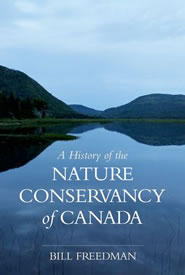Results you can walk on
A review of A History of the Nature Conservancy of Canada
A History of the Nature Conservancy of Canada (Courtesy Oxford University Press CDA)
By Bill Armstrong
While reading Bill Freedman’s history of the first 50 years of the Nature Conservancy of Canada (NCC), I came across the phrase “results you can walk on,” which I think is a concise summary of what the organization is about. Bill was an ecologist and a professor of biology at Dalhousie University, and a long-time member of the NCC Board of Directors, including a term as chair. As is often the case with history books about organizations, he wrote the book after hearing several people say, “someone should write a history…”
Bill’s long span of volunteer work with NCC and his deep commitment to the organization gave him an insider’s perspective on its development and evolution over time, which can be helpful to readers. However, a strong attachment can lead an author to overlook or omit some sensitive details that inevitably arise from time to time in the life of an organization. My sense is that Bill has struck a good balance by presenting the history of NCC objectively, while also acknowledging that board members and staff occasionally had to address contentious topics. For example, drawing from board minutes, Bill, without naming names, describes “lengthy discussions” related to certain decision items, which sometimes continued over several meetings until consensus was reached or the matter was dropped. In another example, he expresses his puzzlement that some provinces chose not to support the Natural Area Conservation Plan (NACP) after it was introduced.
NACPs are public-private partnerships that combine funding to secure and conserve critical landholdings. Again, Bill does not name names, reflecting the organization’s position of eschewing public advocacy in favour of quiet, behind-the-scenes diplomacy, while communicating to governments and the public the merits of science-based conservation work.
Readers interested in learning why organizations go about their work in a certain way, while others operate another way, will find much of interest in Bill’s telling of the evolution of NCC in its governance and operational practices as it worked toward protecting and enhancing critical habitats across Canada. This included a growing realization of the importance of applying rigorous scientific practices to its work, the never-ending need to raise funds to secure and manage properties, and to work with sympathetic landowners who share its values.
The final chapter provides a look-ahead drawing from NCC’s strategic plan for the 2012-2017 period. Writing in 2012, Bill suggests that the organization will grow by continuing to do the things that have made it successful, with eco-regional planning and NACPs being the backbone of its activities.
As with all such histories, of course, time marches on, bringing with it unexpected events like a worldwide pandemic. As a postscript, a curious journalist turned book reviewer wants to know how NCC navigated that shocking event. The 2019–20 annual report to donors offers some clues, including that NCC added almost 35,000 donors and completed 87 projects, securing more than 7,000 additional hectares to its portfolio.
A strategic plan covering 2021 and future years was begun under CEO John Lounds, who retired in late 2020, but its planning was disrupted by the pandemic. In his video message embedded in the online annual report, John states that he expects NCC will come out of the crisis stronger than ever. Incoming president and CEO Catherine Grenier is tasked with the job of guiding the organization through what we all hope is a post-pandemic recovery period. You can learn more about her here >
Read NCC's annual reports to donors here >
A History of the Nature Conservancy of Canada covers the period 1962–2012 and is published by Oxford University Press. Dr. Bill, as he was affectionately known within NCC, died in 2015. You can learn more about the origin of the book here >



